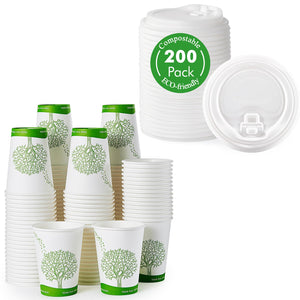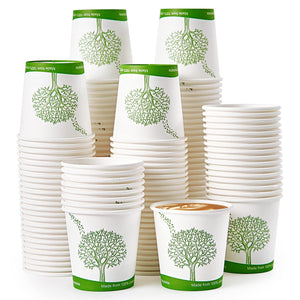When you pick up paper coffee cups, you hold a blend of materials that shape your coffee moment. Most paper coffee cups use paper as the main cup material, with a thin plastic or plant-based lining for insulation and leak protection. These materials help keep your drink warm and your hands comfortable. However, the choice of lining can impact your health and the flavor of your coffee.
According to a study in The Journal of Hazardous Materials, hot drinks can cause billions of microplastics to enter your coffee from the lining in paper coffee cups. This can change the taste and may affect your health.
Sustainable takeaway coffee cups, like Ecolipak’s compostable options, use plant-based linings to protect both you and the environment. By choosing cups with safe cup material and smart insulation, you support better heat retention, a pure coffee experience, and a cleaner planet. Many families and coffee lovers now reach for sustainable takeaway coffee cups to enjoy peace of mind with every sip.
Key Takeaways
-
Paper coffee cups combine paperboard layers with plastic or plant-based linings to keep drinks warm and prevent leaks.
-
Choosing cups with plant-based PLA linings reduces plastic waste and supports composting, unlike traditional PE linings.
-
Double-wall and ripple-wall cups provide better insulation, keeping drinks hot longer and hands comfortable without extra sleeves.
-
Safe inks and adhesives matter; look for cups with food-safe, BPA-free coatings to protect your health and improve recycling.
-
Sustainable takeaway cups, like Ecolipak’s compostable options, help reduce landfill waste and carbon emissions while supporting a cleaner planet.
Paper Coffee Cups: What Are They Made Of?
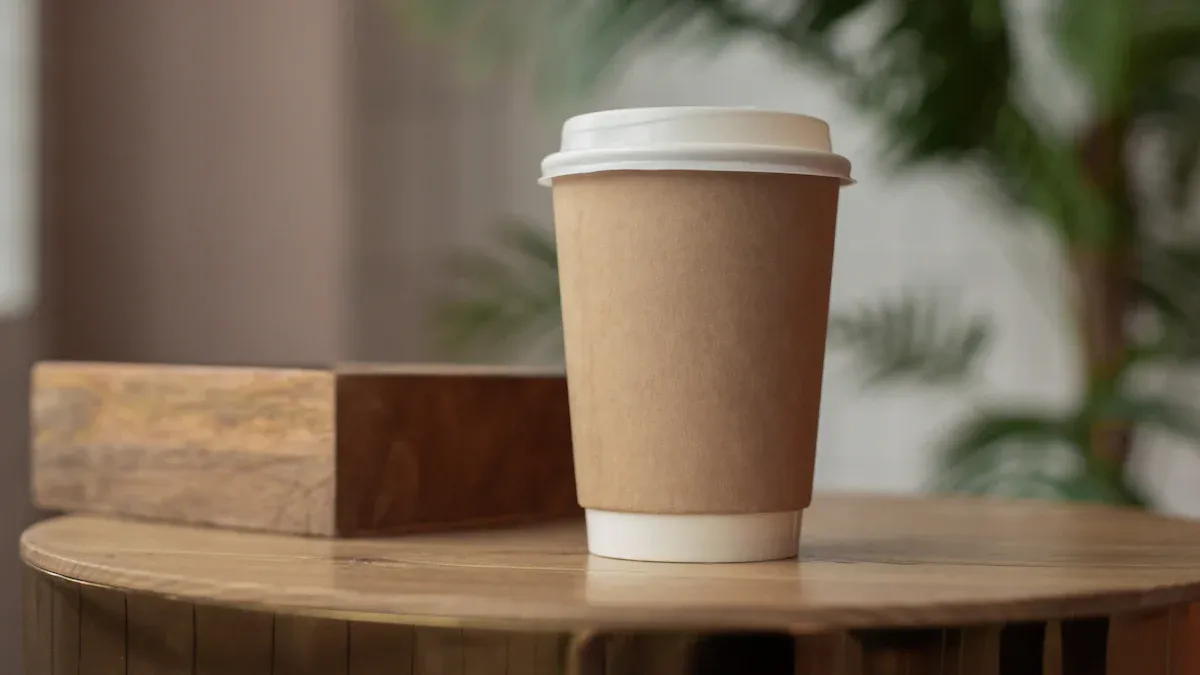
When you look at paper coffee cups, you see more than just a simple container. You hold a product made from several layers and coatings, each chosen for a reason. Understanding the material composition helps you make better choices for your health and the planet. Let’s break down the main parts that make up different varieties of paper cups.
Paperboard Layers
The foundation of most paper coffee cups is the paperboard layer. This cup material comes from wood fiber, often sourced from responsibly managed forests. Many brands use FSC-certified paper to ensure sustainability. Some companies even use renewable resources like bamboo or sugarcane, which are biodegradable and compostable.
You will find that the thickness of the paperboard matters. Manufacturers measure it in GSM (grams per square meter). Here’s how thickness affects your cup:
-
Lightweight (135-200 GSM): These cups cost less but offer less durability. They work best for short-term use.
-
Medium weight (210-280 GSM): These provide a balance between strength and cost. Most coffee shops use this range.
-
High weight (280-340 GSM): These cups feel sturdy and keep drinks hot longer. They are ideal for hot beverages.
Different varieties of paper cups include single-wall, double-wall, and ripple-wall designs. Single-wall cups use one layer, while double-wall and ripple-wall cups add extra layers for better protection. Thicker cup material prevents leaks and keeps your hands safe from heat. The outer layer also gives space for branding and design, making your coffee experience more enjoyable.
Linings: PE vs. PLA
The inside of paper coffee cups needs a special coating to stop leaks. Most cups use either a PE (polyethylene) or PLA (polylactic acid) lining. These coatings play a big role in the material composition and environmental impact of your cup.
Here’s a quick comparison:
|
Aspect |
PLA Lining (Polylactic Acid) |
PE Lining (Polyethylene) |
|---|---|---|
|
Material Source |
Plant-based, renewable resources |
Petroleum-based, non-renewable fossil fuels |
|
Compostability |
Needs industrial composting; not home-compostable |
Not compostable |
|
Recyclability |
Limited, depends on local facilities |
Recyclable where infrastructure exists |
|
Environmental Impact |
Lower carbon footprint; biodegradable in industrial composting |
Higher lifecycle emissions; non-biodegradable |
|
Heat Resistance |
Softens at ~50–60°C |
Excellent for hot beverages |
|
Microparticle Release |
More microparticles under heat |
Fewer microparticles |
|
Cost |
Generally higher, but dropping |
Lower due to established production |
|
Regulatory Alignment |
Matches new environmental rules |
Targeted by anti-plastic policies |
Most standard types of paper cups use PE linings. These coatings come from fossil fuels and make recycling difficult. They also do not break down in landfills. PLA linings, like those used in Ecolipak’s 12 oz Compostable Paper Coffee Cups with CPLA Lids, come from plants such as corn. These coatings are certified compostable under standards like ASTM D6400 and D6868. They break down in commercial composting facilities, helping reduce waste. However, they still need special conditions to compost and are not suitable for home composting.
When you choose cups with plant-based coatings, you support lower carbon emissions and a cleaner environment. Ecolipak’s use of PLA lining and compostable cup material shows a commitment to health and sustainability. This approach matches the best coffee cup material for families and businesses who care about the planet.
Inks and Adhesives
You might not think about the inks and adhesives in your cup, but they matter for both safety and recycling. Most different varieties of paper cups use food-safe inks for branding and decoration. However, some inks and adhesives can migrate into your drink, especially when exposed to heat.
Traditional coatings and adhesives often contain chemicals like mineral oils, dyes, and even PFAS (per- and polyfluoroalkyl substances). These substances can move into your coffee and may pose health risks. PFAS, sometimes called "forever chemicals," can build up in your body and the environment. They also make recycling harder because they do not break down easily.
Newer coatings and adhesives use water-based or plant-based formulas. These options improve recyclability and reduce chemical migration. Ecolipak’s compostable cups use BPA-free, food-grade cup material and coatings, giving you peace of mind with every sip.
When you pick different types of paper cups, look for those with safe inks and adhesives. This choice protects your health and helps keep recycling streams clean. By understanding the material composition and coatings in your cup, you make a positive impact on your family and the environment.
Insulated Paper Cups: How Do They Work?
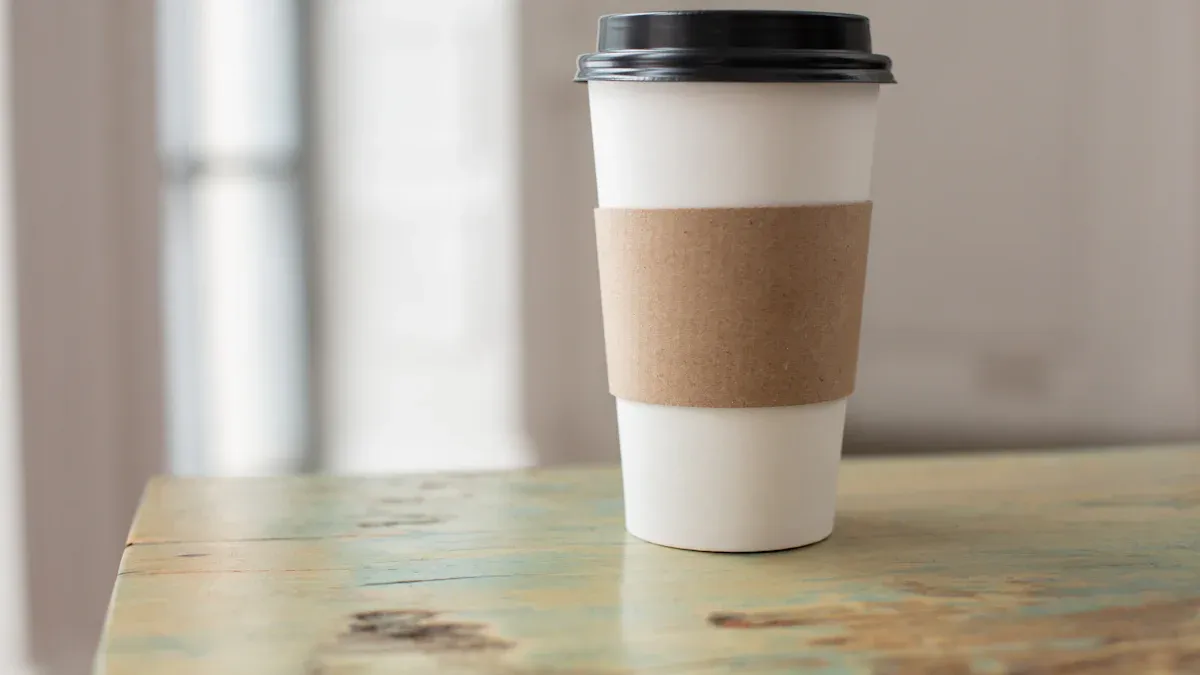
When you pick up a hot drink, you want it to stay warm and easy to hold. Insulated paper cups make this possible. The design and material composition of these cups play a big role in heat retention and insulation. You can find different varieties of paper cups, but insulated paper cups stand out for their ability to keep drinks hot and hands comfortable.
Single-Wall vs. Double-Wall
You may notice that some paper coffee cups feel thin, while others have a thicker, sturdier feel. This difference comes from the cup’s structure. Single-wall cups use just one layer of paperboard. These cups are light and cost-effective. However, they offer minimal insulation. Hot drinks cool quickly, and the outside of the cup can become too hot to touch. You might need a sleeve to protect your hand.
Double-wall paper cups use two layers of paperboard with a small air gap between them. This air gap acts as a barrier, slowing down heat transfer. Your drink stays hot longer, and the cup’s exterior remains comfortable to hold. Laboratory tests show that double-wall paper cups keep beverages warm for a longer time and prevent burns. You do not need an extra sleeve, which makes them safer and more convenient.
|
Feature |
Single-Wall Paper Cups |
Double-Wall Paper Cups |
|---|---|---|
|
Construction |
Single layer of paperboard |
Two layers of paperboard with an air gap between |
|
Insulation |
Minimal insulation; hot drinks cool quickly |
Superior insulation; keeps hot drinks warm longer |
|
Temperature Retention |
Hot beverages cool quickly; cup exterior gets hot |
Maintains beverage temperature; cup exterior stays comfortable |
Most insulated paper cups in coffee shops use double-wall construction. This design gives you better heat retention and user comfort. You can enjoy your drink without worrying about burning your hand or losing heat too quickly.
Ripple and Corrugated Designs
Some insulated paper cups have a wavy or textured surface. These are ripple or corrugated cups. The rippled outer layer creates small air pockets, which boost insulation. Your drink stays hot, and your hand stays cool. Ripple wall cups can keep your beverage above 60°C for about 21 minutes. This is almost as long as double-wall cups, which hold heat for about 24 minutes.
Ripple and corrugated designs also give you a better grip. The texture makes the cup less likely to slip from your hand. You do not need a sleeve because the insulation and grip are built in. Many artisan cafés and mobile coffee stands choose ripple cups for their rustic look and practical benefits.
-
Ripple wall cups have an inner layer and a rippled outer layer that traps air for insulation.
-
They provide a secure grip and a comfortable feel.
-
The design keeps drinks hot and hands safe, reducing the need for extra accessories.
You get both style and function with these types of paper cups. The insulation helps maintain beverage temperature and prevents condensation, so your table stays dry.
Ecolipak’s Approach to Insulation
Ecolipak understands that you want both performance and sustainability. The 12 oz Compostable Paper Coffee Cups with CPLA Lids use a smart approach to insulation. These insulated paper cups feature sturdy paperboard and a plant-based PLA lining. The double-walled insulation keeps your drink hot and your hands safe. You do not need to worry about leaks or burns.
Ecolipak’s insulated paper cups balance heat retention and eco-friendly materials. The PLA lining comes from renewable plants, not petroleum. This makes the cup compostable in commercial facilities. You get the best coffee cup material for your health and the planet. The cup’s design ensures that you enjoy your drink at the right temperature, with no need for extra sleeves or accessories.
Many families and businesses choose Ecolipak’s insulated paper cups for their daily routines and special events. You support a cleaner environment and enjoy a better coffee experience. The combination of insulation, heat retention, and sustainable materials makes these cups a top choice for anyone who cares about quality and the earth.
Tip: When you choose insulated paper cups made with eco-friendly materials, you help reduce waste and protect your family’s health. Ecolipak’s cups offer a simple way to make a positive impact every day.
Sustainable Takeaway Coffee Cups: Why They Matter
Compostable and Biodegradable Options
You make a difference every time you choose sustainable takeaway coffee cups. These cups use eco-friendly materials like PLA, which come from plants such as corn or sugarcane. Unlike traditional cups, compostable and biodegradable options break down quickly in commercial composting facilities—often within 90 days. This means less waste in landfills and fewer greenhouse gases released into the air.
-
Compostable cups decompose into water, CO₂, and biomass, supporting a circular economy.
-
Biodegradable cups help reduce plastic waste and lower carbon emissions.
-
Certified compostable cups, like those with BPI or ASTM D6400 labels, guarantee genuine environmental benefits.
|
Aspect |
Compostable/Biodegradable Cups |
Standard Plastic-Lined Cups |
|---|---|---|
|
Decomposition Rate |
Under 1 month (industrial) |
Up to 20 years (landfill) |
|
Environmental Footprint |
Lower carbon emissions |
Higher emissions, pollution |
|
Disposal Requirements |
Commercial composting needed |
Mostly landfilled |
You help protect your family’s health and the planet by choosing eco-friendly paper hot cups made from safe materials. Remember, proper disposal is key to realizing these benefits.
Ecolipak’s Environmental Commitment
Ecolipak leads the way in sustainable takeaway coffee cups. The brand uses eco-friendly materials and plant-based coatings to create products that are safe for you and the environment. Ecolipak’s compostable cups hold BPI certification, meeting strict ASTM standards for compostability and safety. You can trust that these eco-friendly paper hot cups contain no harmful chemicals like PFAS.
Ecolipak sold over 59 million eco-friendly paper hot cups and other products in 2024, helping protect 125,000 square meters of green space. The company’s commitment to innovation and quality means you get the best coffee cup material for your daily routine. Ecolipak’s products support a cleaner planet and healthier communities.
Choosing Ecolipak means you support a brand that values environmental protection and family health.
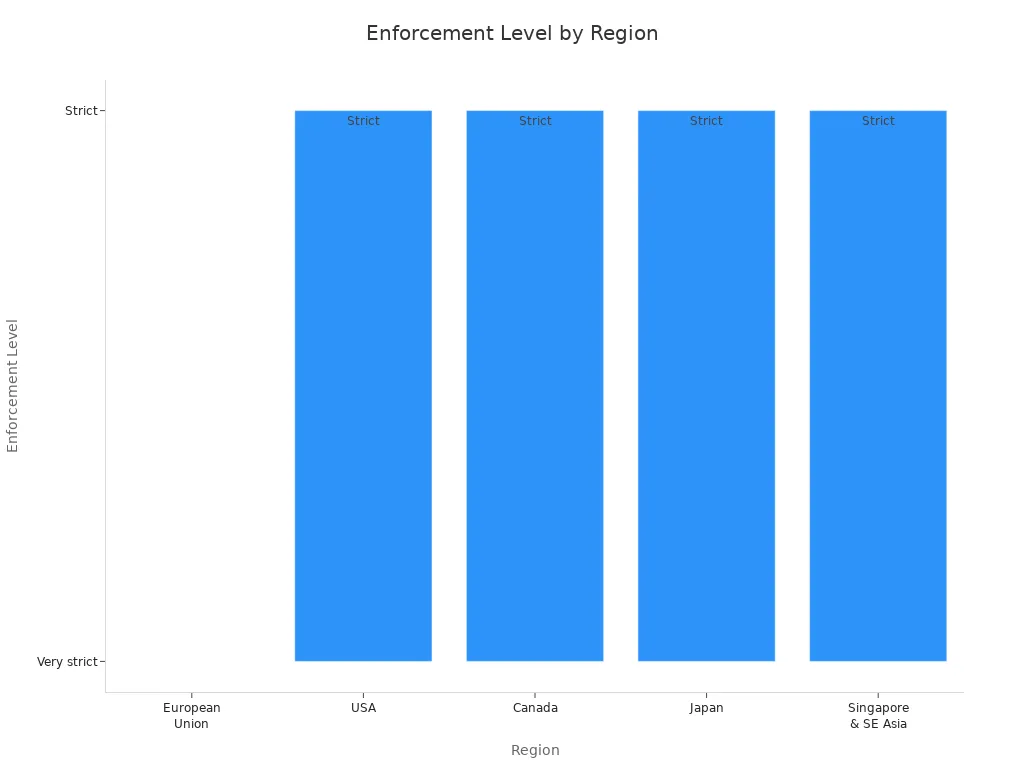
Choosing Greener Cups
You have the power to shape a better future with your choices. Most families and coffee lovers now prefer sustainable takeaway coffee cups made from eco-friendly materials. Over 80% of consumers look for packaging that supports environmental protection. When you select cups with clear compostable labeling and trusted certifications, you help reduce landfill waste and carbon emissions.
-
Look for eco-friendly paper hot cups with BPI or ASTM D6400 certification.
-
Choose cups made from renewable materials and plant-based coatings.
-
Support brands that invest in sustainable practices and transparent labeling.
Sustainable takeaway coffee cups offer durability, heat retention, and peace of mind. You enjoy your favorite drinks while caring for your family’s health and the planet. As more cities expand composting infrastructure, your choices will have an even greater impact.
You now know that the material composition and coatings in paper coffee cups shape your coffee experience. Insulated paper cups, especially double-wall paper cups, use double-walled insulation and eco-friendly materials to improve heat retention and comfort. Ecolipak’s eco-friendly paper hot cups use the best coffee cup material for both safety and sustainability. Studies show that sustainable takeaway coffee cups help reduce waste, but proper disposal and clear labeling matter. When you choose different varieties of paper cups made from safe cup material, you support your family’s health and protect the planet.
FAQ
What makes paper coffee cups different from regular plastic cups?
You find that paper coffee cups use renewable cup material and plant-based coatings. These materials help reduce plastic waste. Many families choose them for a safer, more eco-friendly option that supports both health and environmental protection.
How do insulated paper cups keep drinks hot?
Insulated paper cups use double-walled insulation or ripple designs. These structures trap air and slow heat loss. You enjoy better heat retention, so your coffee stays warm and your hands stay comfortable.
Are there different varieties of paper cups for hot and cold drinks?
Yes, you can choose from different varieties of paper cups. Some types of paper cups have extra insulation for hot drinks, while others use lighter materials for cold beverages. Always check the material composition for the best coffee cup material for your needs.
Why should I pick sustainable takeaway coffee cups?
Sustainable takeaway coffee cups use eco-friendly materials and compostable coatings. You help protect the planet and your family’s health. These cups break down faster in composting facilities, reducing landfill waste and pollution.
What should I look for in eco-friendly paper hot cups?
You should look for cups made from safe cup material, with plant-based coatings and clear compostable labels. Double-wall paper cups offer strong insulation. Choosing eco-friendly paper hot cups supports your health and the environment.




